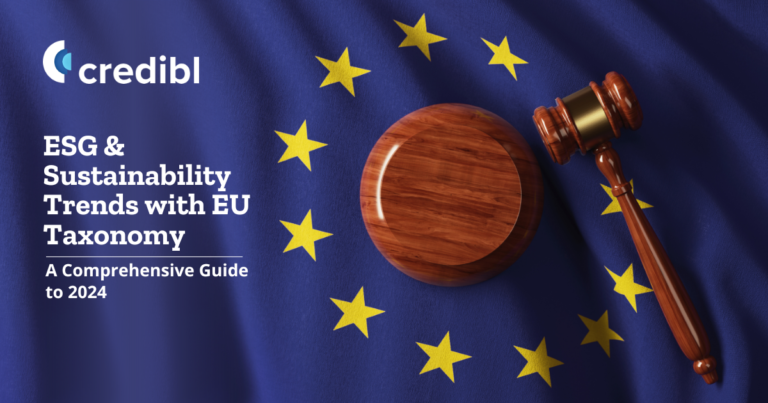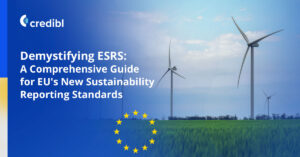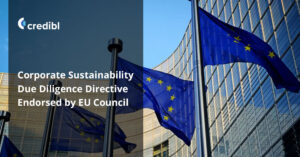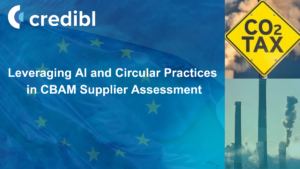Introduction
The landscape of ESG (Environmental, Social, and Governance) regulations is rapidly evolving, shaping the way businesses operate and influencing investment trends. As we step into 2024, understanding these changes becomes crucial for companies and investors alike. This blog navigates through the complex world of ESG regulations, focusing on the European Union’s efforts to harmonize and strengthen sustainability reporting and practices.
Understanding ESG Regulations and EU Taxonomy
ESG regulations are government standards designed to improve transparency and accountability in environmental, social, and governance aspects of business operations. They are instrumental in combating greenwashing and ensuring companies adopt sustainable practices. The EU Taxonomy, a cornerstone of these regulations, is a classification system identifying environmentally sustainable economic activities within the EU, crucial for the EU’s Sustainable Finance Action Plan.
Recent Trends in ESG Regulation
ESG regulations have witnessed a staggering 155% increase over the last decade, reflecting the urgent need for sustainable policy interventions. This rise is a response to market demands for more transparent and effective ways to channel capital into sustainable businesses. As sustainability considerations become integral to business operations, companies must stay abreast of these evolving regulations.
Key ESG Regulations to Watch in 2024
As we edge closer to 2024, several key ESG regulations will come into sharper focus, reshaping the landscape for businesses across Europe. Understanding these regulations is vital for companies to remain compliant and leverage opportunities for sustainable growth.
- Sustainability Disclosure Requirements (SDR): Originating from the UK Financial Conduct Authority (FCA), the SDR aims to enhance the sustainability information available to the UK’s asset management sector. Its primary goal is to combat greenwashing and provide investors with clear, accurate sustainability data. The FCA, after a significant consultation period, plans to finalize these rules by the end of the fourth quarter of 2023, addressing various sustainable finance areas, including sustainable investment labels and disclosure requirements.
- The Sustainable Finance Disclosure Regulation (SFDR): A mandatory regulation by the European Parliament, the SFDR targets investors and financial market participants. It became obligatory on January 1, 2023, intending to make the sustainability profile of funds more transparent and comprehensible, thereby steering capital into sustainability-focused firms. The SFDR classifies investment products into distinct groups based on sustainability, requiring financial market participants to adhere to specific disclosure obligations. Consultations on potential amendments to the SFDR were launched in 2023, with the possibility of updates to the regime by the end of 2023 or early 2024.
- The EU Taxonomy: This mandatory classification system, crucial for the EU’s sustainable transition, became effective on January 1, 2023. It establishes criteria for defining sustainable economic activities, aiming to reduce greenwashing and guide investments towards environmentally sound choices. Large companies and financial market participants within the EU must now publicly disclose their alignment with the Taxonomy’s criteria, a mandate that has broadened to include all six environmental objectives defined by the Taxonomy.
- The Corporate Sustainability Reporting Directive (CSRD): This directive, which came into force on January 5, 2023, expands the existing Non-Financial Reporting Directive (NFRD). It encompasses a wider array of large EU-listed entities, including businesses, banks, and insurance companies. The CSRD demands detailed reporting on various sustainability-focused topics, such as environmental matters, social responsibility, human rights, anti-corruption measures, and board diversity. The new rules applicable from the financial year 2024, emphasize double materiality – the influence of environmental and social matters on a company’s development and vice versa.
- The Corporate Sustainability Due Diligence Directive (CSDDD): Still pending, this directive from the European Parliament will require large EU companies and non-EU companies with significant EU undertakings to exercise due diligence in their business lines and value chains. The CSDDD, passed by the EU parliament in June 2023, is designed to mitigate human rights or environmental risks and violations. Companies will need to integrate due diligence into their policies, perform risk analyses, and establish a complaints procedure, among other measures.
- Streamlined Energy and Carbon Reporting (SECR): A policy of the UK Government, the SECR obliges large enterprises, publicly listed companies, and Limited Liability Partnerships (LLPs) to report their energy consumption and carbon emissions. Introduced in April 2019, this regulation aims to broaden the scope of reporting and promote energy efficiency initiatives. SECR applies to a large number of companies and includes the disclosure of energy usage and carbon emissions in annual reports.
- The German Supply Chain Due Diligence Act (LkSG): This mandatory act by the German Parliament affects German and non-German companies with a significant employee base. Effective from January 1st, 2023, it demands companies to adhere to social and environmental standards throughout their supply chain. The LkSG is set to expand its scope in 2024 to include companies with 1,000 employees, significantly increasing the range of businesses under its purview.
- EU Carbon Border Adjustment Mechanism (CBAM): Initiated on October 1, 2023, the EU’s Carbon Border Adjustment Mechanism (CBAM) is a pivotal strategy to combat carbon emissions, targeting goods such as cement, iron, steel, aluminum, fertilizers, electricity, and hydrogen. This transitional phase, ending January 31, 2024, is designed as a pilot to refine methodologies for future application, ultimately aiming to cover over 50% of emissions in sectors under the EU Emissions Trading System (ETS). During this phase, importers are required to report embedded greenhouse gas emissions in their imports, both direct and indirect, without financial implications. This reporting, crucial for sectors like cement and fertilizers, allows flexibility until the end of 2024, with options including full reporting according to EU methodology, equivalent methods, or default reference values. The EU Commission has developed IT tools and comprehensive guidance to aid businesses in compliance. Each of these regulations brings its own set of challenges and opportunities. Businesses need to be proactive in understanding and integrating these regulations into their operational strategies to ensure compliance and leverage their potential for sustainable growth.
Impact of EU Taxonomy on Businesses and Investments
The implementation of the EU Taxonomy has significantly influenced both corporate operations and investment strategies within the EU and beyond. This influence is evident from the way companies are restructuring their reporting mechanisms to comply with the Taxonomy’s requirements.
- Corporate Adaptation and Reporting Requirements: Since January 1, 2022, companies subject to the Non-Financial Reporting Directive (NFRD) have been required to disclose activities qualifying as “environmentally sustainable” under the Taxonomy Regulation. With the replacement of NFRD by the Corporate Sustainability Reporting Directive (CSRD) starting from the financial year 2023, an even larger number of companies are mandated to report on their environmental sustainability. They must disclose proportions of turnover, capital expenditure, and operating expenditure linked to the Taxonomy’s environmental objectives, along with information on how they do not significantly harm other environmental criteria and meet social and governance safeguards. This shift urges companies to reassess their operational and reporting systems, ensuring alignment with the Taxonomy and the required data for relevant disclosures.
- Effect on Corporate Financing: The EU Taxonomy provides an opportunity for companies to transparently and comparably measure their performance and progress towards environmental objectives. A strong alignment with the Taxonomy can enhance a company’s reputation, making it more attractive to banks and investors. This aspect of the Taxonomy transforms it from a mere regulatory requirement into a strategic asset for companies, potentially improving their access to finance and investment opportunities.
- Influence on Investors and Financial Institutions: Asset managers and investment firms now need to disclose Key Performance Indicators that demonstrate the alignment of their portfolios with the Taxonomy. Banks are also required to disclose their Green Assets Ratios (GAR). The SFDR requires financial market participants in the EU to reveal the extent of their alignment with the EU Taxonomy for specific investment products. This requirement underscores the increasing importance of sustainable investing and the role of the EU Taxonomy in guiding investment decisions.
- Global Impact Beyond EU Borders: The EU Taxonomy’s influence extends beyond the European Union, affecting non-EU companies due to the global nature of financial markets and trade flows. Non-EU investors or financial advisors offering products in Europe are subject to the SFDR, necessitating alignment with the EU Taxonomy. Non-EU companies with EU-based investors will likely need to provide information on their alignment with the EU Taxonomy, demonstrating the Taxonomy’s far-reaching impact on global business practices and investment strategies.
Navigating Compliance: Standards and Frameworks
In the face of these diverse and complex regulations, companies must navigate a maze of standards and frameworks to ensure compliance. The distinction between regulations and standards is crucial here. While regulations mandate specific actions or disclosures, standards provide benchmarks and guidelines to achieve these regulatory requirements.
- Regulations vs. Standards: For instance, the CSRD regulation requires businesses of a certain size and capacity to report on sustainability topics. The standards underpinning this regulation have been created by the European Financial Reporting Advisory Group (EFRAG) and are expected to be adopted by mid-2023. For the SFDR, there are several voluntary standards and norms that companies can use, such as those set by the GRI, CDSB, SASB, and CDP. These standards, while valuable in their own right, do not offer a one-size-fits-all approach, highlighting the complexity of achieving regulatory compliance.
- Supportive Frameworks: Various frameworks are available to assist organizations in their compliance efforts. These may take the form of questionnaires or guides on meeting regulatory requirements for internal teams. Companies are advised to thoroughly examine these frameworks to gain a deeper understanding of compliance requirements. This approach is essential for companies to align and mature their reporting frameworks, especially as taxonomy reporting becomes integrated into the CSRD, requiring mandatory assurance.
- Data Quality and Comparability Challenges: A recent study by PwC on EU Taxonomy reporting for the financial year 2022 highlights significant challenges in data quality and comparability, even within the same sectors. This is due to diverse methodologies applied by different companies. For instance, the gap between taxonomy-eligible and taxonomy-aligned economic activities shows the potential for companies to further align their practices with EU sustainability objectives. Financial institutions, in particular, face challenges due to their reliance on reported data from their counterparties, mostly industrial companies, for their reporting. This has led to an inadequate data basis, affecting the quality of disclosure.
The Future of ESG Regulations and EU Taxonomy
As we look ahead, the landscape of ESG regulations and the EU Taxonomy is set to evolve further. Companies must continue grappling with the complexity of the EU Taxonomy, especially as reporting on additional environmental objectives becomes imminent. The discrepancies in reporting practices indicate a need for more standardized methodologies and clearer guidelines. The ongoing developments in ESG regulations underscore the need for continuous adaptation and vigilance by businesses to stay compliant and leverage the opportunities these changes present.
Conclusion
The evolution of EU Taxonomy and ESG regulations marks a significant shift in the business landscape, emphasizing sustainability and transparency. Companies must navigate these changes strategically, adapting their operations and reporting practices to comply with the evolving regulatory requirements. The impact of these regulations is far-reaching, influencing not only EU-based companies but also those around the globe. As the world moves towards a more sustainable future, staying informed and compliant with these regulations will be crucial for businesses aiming to thrive in this new era.







